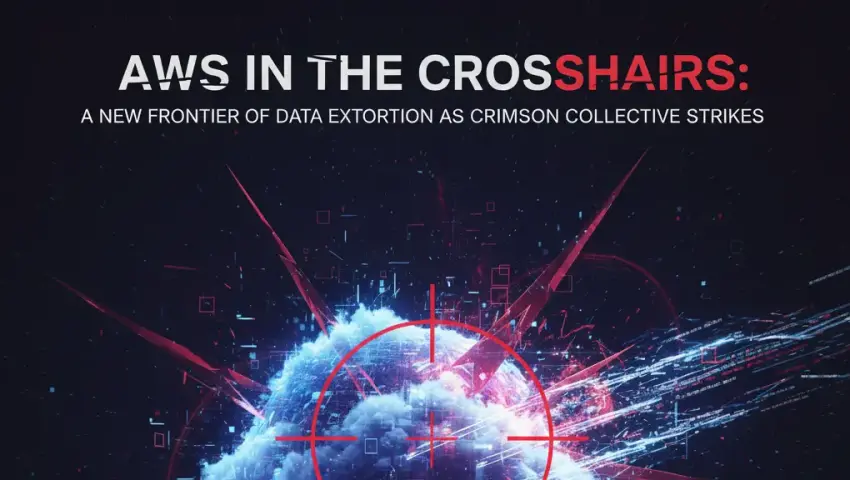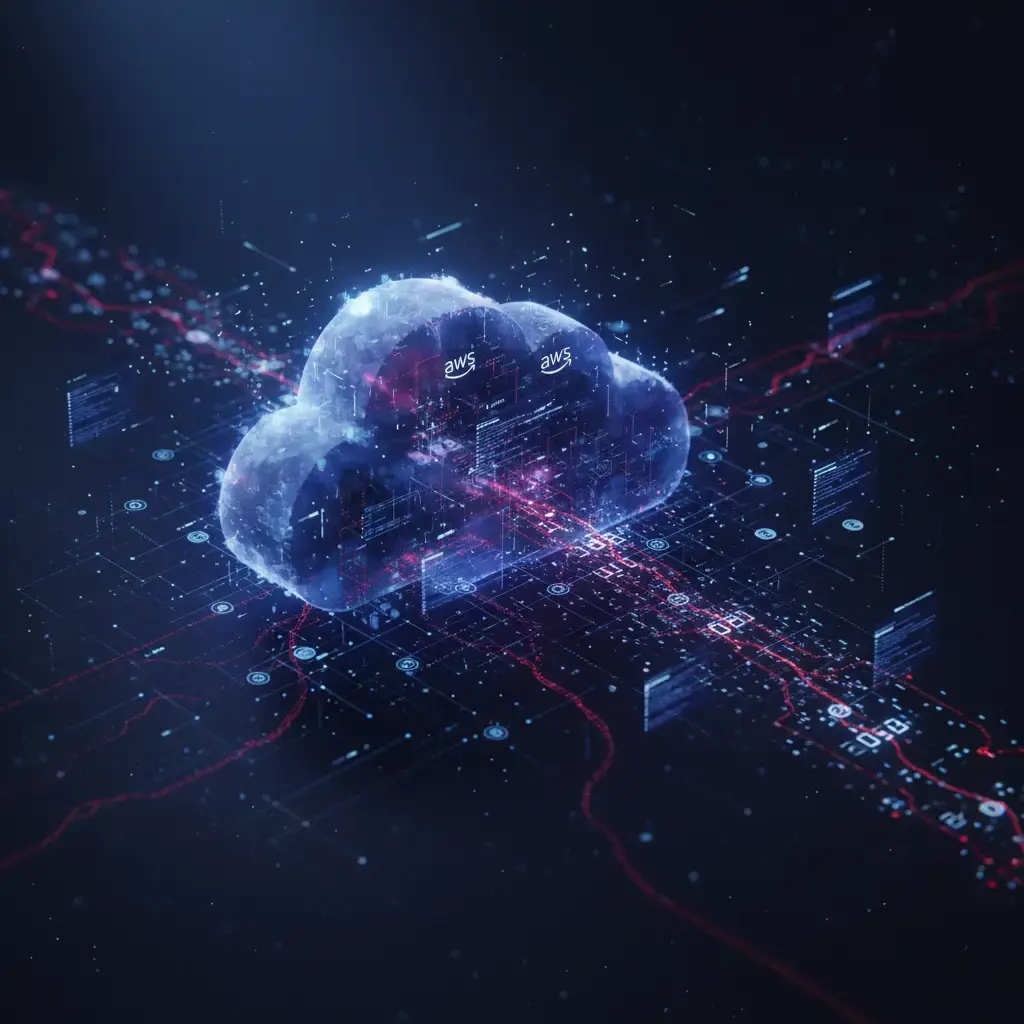
AWS in the Crosshairs: A New Frontier of Data Extortion as Crimson Collective Strikes
The digital battlefield is ever-shifting, and the shadows within it grow longer, cast by audacious new adversaries. Just when the echoes of their audacious breach against Red Hat began to fade, the notorious Crimson Collective has unveiled its next terrifying chapter. This isn't just another opportunistic strike; it's a strategic pivot, a focused assault on the very infrastructure that powers modern enterprise: Amazon Web Services (AWS) environments.
Across the globe, businesses unknowingly stand on the precipice. The Collective isn't merely probing defenses; they are meticulously harvesting exposed AWS credentials, orchestrating a silent invasion, escalating privileges, and siphoning off vast reservoirs of critical data for the chilling purpose of extortion. This isn't a drill. Your cloud is now their hunting ground.

The Crimson Collective: A Shadow Growing Bolder and Shifting Tactics
Who are They? A Rapidly Evolving Threat
The Crimson Collective emerged from the murky depths of the dark web with a clear, ruthless agenda: data theft and extortion. Unlike some ransomware groups that merely encrypt data, the Collective's primary goal appears to be the exfiltration of sensitive information, which they then use as leverage for massive payouts. Their methods suggest a high degree of sophistication, adaptability, and a keen understanding of modern IT infrastructures.
The Red Hat Precedent: A Dress Rehearsal for Cloud Attacks
Their recent, high-profile exploit against Red Hat served as a stark warning to the cybersecurity community. The group claimed to have stolen “approximately 570 gigabytes of compressed data from more than 28,000 internal development repositories” from a Red Hat consulting GitLab instance, according to security reports. [1][2] This wasn't just random data; it included sensitive Customer Engagement Reports, which act as a virtual blueprint of a client’s digital environment. These reports can contain critically revealing information, such as credentials, network diagrams, architecture layouts, and strategic project plans. [3]
Such a breach highlights not only the Collective's technical prowess but also their strategic intelligence. By compromising a major vendor, they likely gained insights and potential access vectors into numerous downstream client environments. It was, in essence, a high-stakes intelligence-gathering operation that set the stage for their next, even more ambitious target.
The Strategic Shift: Why AWS?
With alarming agility and calculated precision, the Crimson Collective has now shifted its gaze to the cloud. As security firm Rapid7 noted in their report, the Crimson Collective is a new threat group “observed operating in AWS environments, using leaked long-term access keys and leveraging overly permissive configurations of IAM entities.”[4]
This isn't just about targeting high-profile entities; it’s about exploiting a systemic vulnerability that many businesses, lulled into a false sense of security by the perceived resilience of cloud providers, have overlooked. Cloud infrastructures, especially hyper-scale platforms like AWS, represent the ultimate prize for data extortionists. They host vast quantities of sensitive data, critical applications, and the core operational logic of modern enterprises. Compromising these environments offers unparalleled access and leverage.
The Cloud’s Achilles’ Heel: Exploiting Exposed AWS Credentials and Misconfigurations
The Digital Keys to the Kingdom: AWS Credentials
How does a threat group, even one as sophisticated as the Crimson Collective, gain a foothold in something as vast and intricate as AWS? The answer, disturbingly, often lies in the simplest of oversights: exposed AWS credentials.

These aren't just obscure technical codes; they are the master keys to your digital kingdom within the cloud. An AWS Access Key ID and Secret Access Key pair grants programmatic access to an AWS account, effectively acting as a username and password for automated processes, applications, or even human administrators. If these keys are compromised, the attacker can wield the same power as the legitimate user.
Common Exposure Vectors: Where Attackers Hunt
The Collective actively hunts for these digital breadcrumbs, utilizing tools like the open-source TruffleHog to "find leaked AWS credentials" that may be exposed in code repositories or other sources. [5]
Common vectors for credential exposure include:
Public Code Repositories: Developers often inadvertently commit AWS keys directly into Git repositories (like GitHub, GitLab, Bitbucket), which are then made public. Automated scanners constantly trawl these repositories, searching for these golden tickets.
Misconfigured Cloud Storage: Credentials or sensitive configuration files containing keys might be stored in publicly accessible S3 buckets or other cloud storage services due to oversight.
Insecure Application Code: Hardcoding credentials directly into applications that are publicly exposed can offer a direct pathway to compromise.
Compromised Developer Workstations: If a developer's local machine is compromised, their stored AWS credentials can be exfiltrated.
Phishing/Social Engineering: Attackers can trick legitimate users into revealing their credentials through deceptive emails or websites.
Leveraging Over-Permissive IAM Policies
Beyond simply obtaining credentials, the Crimson Collective also preys on another critical vulnerability: overly permissive Identity and Access Management (IAM) configurations. Even if a credential grants limited initial access, an overly broad IAM policy can quickly allow an attacker to escalate their privileges to gain full administrative control. For instance, an IAM user or role might have permissions that are far too extensive for its actual function, enabling an attacker to perform actions they shouldn't be able to.
The Silent Invasion: From Initial Cloud Access to Catastrophe
The Attack Chain: A Methodical, Stealthy Progression
Once these digital keys are seized, the path to compromise is chillingly direct. The Crimson Collective doesn't launch a frontal assault; they execute a methodical, stealthy progression that allows them to maximize their foothold and exfiltration capabilities:

Initial Access: With legitimate access tokens, the Collective can bypass traditional perimeter defenses. They don't need to break *into* your system; they simply *log in* as if they were a legitimate user or application.
Establish Persistence: To ensure they maintain access even if the compromised credential is revoked, the group has been observed creating new IAM users and access keys. [6] This gives them multiple backdoors into your environment.
Privilege Escalation: From initial access, they methodically seek out configurations that allow them to gain broader control. They then attach "AdministratorAccess to their new users," granting them full control over the account. [7] This allows them to move laterally across your AWS accounts, services, and data stores, gaining a comprehensive understanding of your cloud architecture.
Discovery and Data Identification: They meticulously map the AWS environment, identifying high-value targets such as databases (RDS, DynamoDB), storage buckets (S3), and critical application servers. They understand that not all data is equally valuable for extortion; they prioritize sensitive customer information, intellectual property, financial records, and operational blueprints.
Data Exfiltration: They quietly siphon off vast reservoirs of critical data. The group has been observed creating database snapshots and exporting them to S3 buckets for exfiltration, which can then be easily downloaded. [4] This stage is often executed with low-and-slow techniques to avoid detection by rudimentary monitoring systems.
The Unseen Threat: Why "Silent" is So Dangerous
This isn't a loud, disruptive ransomware attack that immediately brings systems to a halt. This is a silent, insidious infiltration. The Crimson Collective operates with surgical precision, often remaining undetected for extended periods—weeks or even months—while they map out the AWS environment, identify high-value targets, and extract information. The chilling reality is that by the time an organization discovers the intrusion, its most precious data may already be in the hands of the attackers.
The Aftermath: Beyond the Ransom Demand
The subsequent extortion demands are often exorbitant, threatening public exposure of sensitive data, regulatory fines, and irreparable damage to reputation. But the cost goes far beyond any ransom. The impacts are multifaceted and devastating:
Reputational Damage: A data breach erodes customer trust and can severely harm a brand's image, making recovery a long and arduous journey.
Operational Disruption: Even if data is not encrypted, the investigation and remediation process can cause significant operational downtime and resource drain.
Regulatory Penalties: Non-compliance with data protection regulations (like GDPR, HIPAA, CCPA) after a breach can lead to hefty fines that can cripple a business.
Legal Ramifications: Lawsuits from affected customers, partners, and shareholders are common following significant data breaches.
Competitive Disadvantage: Loss of intellectual property can undermine a company's market position and innovation efforts.
Supply Chain Compromise: A breach in one organization can have ripple effects throughout its supply chain, affecting partners and customers.
Fortifying the Digital Frontier: Your Shield Against the Storm with Cy-Napea®
The Shared Responsibility Model: Understanding Your Role
In this new era of cloud-centric threats, complacency is a luxury no business can afford. Relying solely on the cloud provider's inherent security is a dangerous gamble. While AWS offers robust infrastructure, it operates under a "Shared Responsibility Model." AWS is responsible for the security *of* the cloud (the underlying infrastructure), but customers are responsible for security *in* the cloud (their data, applications, operating systems, network configuration, and IAM policies). As AWS itself advises, customers should “use short-term, least-privileged credentials and implement restrictive IAM policies.”[5] The responsibility for securing your data and configurations within that infrastructure rests squarely with you.
Beyond Basic Defenses: A Unified, Proactive Approach
This is where a proactive, intelligent defense becomes not just an advantage, but an absolute necessity. Traditional antivirus or simple firewall rules are woefully inadequate against sophisticated adversaries like the Crimson Collective, especially in dynamic cloud environments. Cy-Napea®'s unified cybersecurity platform stands as your unyielding shield against the rising tide of sophisticated threats.
We equip your organization with the capabilities essential to detect, deter, and defeat these insidious cloud attacks:

Advanced Threat Detection (XDR/MDR): Our Extended Detection and Response (XDR) capabilities provide comprehensive visibility across your entire digital footprint, including your critical AWS environments. We don't just look for known threats; we actively hunt for anomalous behavior, privilege escalations, and unusual data movements that signal an unfolding attack – precisely the tactics employed by the Crimson Collective. This means correlating alerts from AWS CloudTrail, VPC Flow Logs, GuardDuty, and other sources with endpoint and network telemetry to paint a complete picture of an intrusion.
Proactive Credential and Access Management: We help enforce stringent access controls and implement the principle of least privilege, ensuring that users and services only have the permissions they absolutely need. Our solutions assist in identifying and remediating exposed credentials, rotating keys regularly, and enforcing Multi-Factor Authentication (MFA) across all AWS accounts, severely limiting an attacker's ability to leverage stolen keys.
Continuous Monitoring and Incident Response: Real-time monitoring and automated alerts mean that any attempt to harvest credentials, establish persistence, or escalate privileges is flagged immediately. Our Managed Detection and Response (MDR) services provide expert human analysis around the clock, turning raw alerts into actionable intelligence and orchestrating rapid containment before exfiltration occurs. This round-the-clock vigilance is critical for catching stealthy cloud attacks.
Cloud Security Posture Management (CSPM): We help you continually assess and improve your AWS security posture, identifying misconfigurations, overly permissive IAM policies, and insecure storage settings before they can be exploited. This proactive approach helps close the "Achilles' Heel" vulnerabilities that the Crimson Collective seeks.
Data Protection and Backup: Even in the worst-case scenario, our robust data protection and geo-redundant backup solutions ensure that your critical information is recoverable and resilient. This drastically undermines the Crimson Collective's primary extortion leverage, as you won't be forced to pay a ransom for data you can restore.
The Crimson Collective's pivot to AWS is a clarion call to action. The cloud is no longer an abstract IT concept; it is the lifeblood of your operation, and it is under direct assault. Don't wait for your critical data to become the next trophy in their collection. Partner with Cy-Napea® and transform your AWS environment from a vulnerable target into an impregnable fortress.
Secure your cloud. Secure your future. Talk to a Cy-Napea® expert today.
Disclaimer:
This article is provided for informational and educational purposes only and is based on publicly available intelligence regarding cybersecurity threats and incidents as of the date of publication. While every effort has been made to ensure the accuracy of the information, the cybersecurity landscape is constantly evolving. Threat actor tactics, techniques, and procedures (TTPs) can change rapidly. Readers should conduct their own independent research and consult with cybersecurity professionals to assess their specific risks and implement appropriate security measures.
The mention of specific companies, products, or services (including AWS and Red Hat) is for illustrative and contextual purposes only and does not imply endorsement, affiliation, or criticism by Cy-Napea®, nor does it guarantee protection against all possible threats. Cy-Napea is not responsible for any actions taken or not taken based on the information presented in this article.




